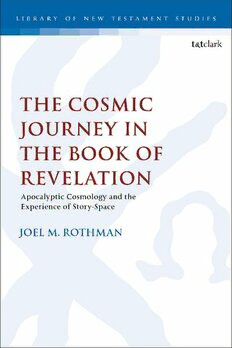
The Cosmic Journey in the Book of Revelation: Apocalyptic Cosmology and the Experience of Story-Space PDF
199 Pages·2023·15.144 MB·English
Most books are stored in the elastic cloud where traffic is expensive. For this reason, we have a limit on daily download.
Preview The Cosmic Journey in the Book of Revelation: Apocalyptic Cosmology and the Experience of Story-Space
Description:
Joel Rothman considers the significance of cosmology in biblical and extra-biblical texts, and the role of the cosmic journey in many apocalyptic narratives. He posits that Revelation’s narrative likewise takes the hearer on a virtual journey, through a cosmic story-space of great theological significance. While scholarship commonly assumes a three-tiered cosmos in Revelation, Rothman argues that Revelation’s narrative operates in a four-tiered cosmos, with the hyper-heaven sitting above the sky-heaven, earth, and abyssal depths; a cosmic story-space that is recreated in the imagination of the hearers.Beginning with a methodology of visual narrative reading, Rothman then discusses the assumptions and existing conceptions regarding heaven and earth. He stresses that Revelation does not exhibit tension in its portrayal of heaven, between heaven as a site of conflict and heaven as the realm in which God truly reigns, but rather shows readers a sky-heaven characterised by archetypal conflict between powerful sky-beings and a hyper-heaven defined by full recognition of the Throne. In journeying through the sky-structure and God-space, and by analysing the four cosmic layers in operation, the distinct nature of the two sky-spaces, cosmic change and the ideological import of the cosmic structure, Rothman proves that the existence of the hyper-heaven–in contradistinction with the limited lived-cosmos of earth and sky-heaven–is a present guarantee of the final cosmic transformation that creates a new space for human life exclusive of imperial draconian elements.
See more
The list of books you might like
Most books are stored in the elastic cloud where traffic is expensive. For this reason, we have a limit on daily download.
